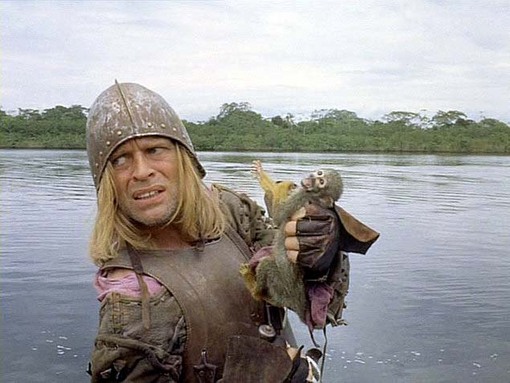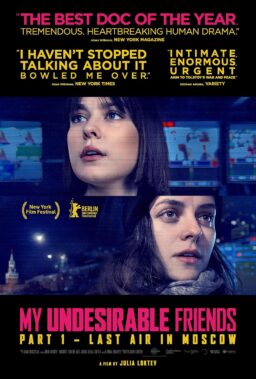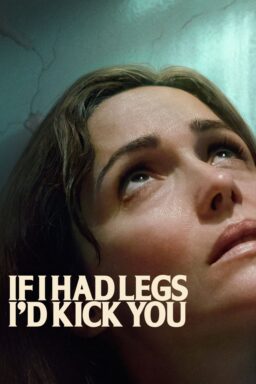“People should look straight at a film… That’s the only way to see one. Film is not the art of scholars, but of illiterates. And film culture is not analysis, it is agitation of the mind. Movies come from the country fair and circus, not from art and academicism.”
— Werner Herzog, 1978 interview quoted in John Sandford’s book, “The New German Cinema” (1980)
We knew it was going to be interesting. Seeing “Aguirre, the Wrath of God” (1972) for the first time in 25 years (even though I’d seen it many times before) with Werner Herzog, Ramin Bahrani, Roger Ebert and a Conference on World Affairs Cinema Interruptus audience in Boulder, CO, last week reconfirmed that not only is Herzog a magnificent, instinctive director, but a first-class showman in the carnival tradition, a compelling speaker and storyteller, and a wonderful actor. Some of the wild tales he related to the audience in Macky Hall are, I’m told, also on the director’s commentary track of the American DVD of “Aguirre” — and some I’ve heard him tell many times over the years, but there’s nothing quite like hearing Herzog spin his spiels in the flesh — even (or maybe especially) when he’s a booming voice in the dark.
The voice, and the diction, are essential to his voodoo. No wonder it has inspired YouTube videos in which someone imitates the director reading Herzogian versions of children’s books such as “Curious George,” “Madeline,” and “Mike Mulligan and His Steam Shovel.” (“In truth, children are next door to sociopaths. The smallest girl was Madeline…”)
On a CWA panel called “My Obsession,” Herzog claimed he was just a normal guy and was visibly appalled by what he later (offstage) deemed the “crazy” effusions of universal love from hand-holding New Orleans singer Lillian Boutté — a sentimental attitude that moved to him to denounce five-year-old children as monstrous pigs, and 25-year-olds as larger, older pigs. After he launched into a typical diatribe about the evils of psychotherapy, fellow panelist Julia Sweeney facetiously asked him if he had now become a Scientologist. He responded to the effect that he also had little use for Dianetics. (One of my earliest, indelible memories of Herzog was when he came to Seattle with “Woyzeck” in 1979 and said of psychology: “A room illuminated to its farthest corner is uninhabitable.” I love the phrase — and I think it’s true about actual rooms — but I think the surprisingly romantic psychological sentiment is bunk.)
No filmmaker since Alfred Hitchcock has been more effective at mythologizing his “brand” than Herzog, long known in Colorado as the perennial “Wild Man” of the Telluride Film Festival. Indeed, as I mentioned to the CWA audience, most (if not all) of his films are on some essential level about the struggle of Werner Herzog to make the movie you are watching. Certainly “Aguirre” and “Fitzcarraldo” (1982) fall into that category — and the mesmerizing documentary “La Soufrière: Waiting for an Inevitable Catastrophe” (1977), an impromptu screening of which we arranged on the last day of the Interruptus, when Julia and I held forth on our mutual history with “Aguirre” and Herzog in the absence of Werner and Ramin. (More about that later.)

In the first, two-hour Interruptus session on Monday, we made it through 17 and a half minutes of “Aguirre” itself, as Herzog, Bahrani and members of the audience called out to stop the film at any time for questions or comments. This slow start is not uncommon. (As I recall, when I did “No Country for Old Men” as an Interruptus film in 2008, we made it through only ten minutes of the film the first day — but that was mostly because I couldn’t stop talking about how each image built upon the others.) In a format like this, some setting-up of the film is required, and Herzog kicked off with a long story about the first few shots of the ant-like trail of Spaniards and Indians descending the vertiginous slopes of the Peruvian Andes — an astounding image that had to be accomplished in one take because there was no way to get nearly 500 people back up the craggy paths of the mountain again.
Also, when the process begins, the audience inevitably wants to try out the rules of the game to see if they really work. People stop the film to ask questions even when they don’t really have one, perhaps because they desire acknowledgment or they want to test the power that has suddenly been entrusted to them. Anyway, if you figure that we spent 15 minutes on introductions and explaining the nature of the process, leaves us with 87 and a half minutes of questions and answers for 17 and a half minutes of film. If we estimate that the average question and answer took 3 minutes, that’s about 29 interruptions, or approximately one every six seconds (if I did the math right, which I probably didn’t). Of course, many of Herzog’s remarks were considerably longer, but (as usually happens on the first day) the pace drove many in the audience almost as insane as Klaus Kinski‘s Don Lope de Aguirre, and you can’t really blame them.
Still, I find the process endlessly fascinating and rewarding. But let’s be honest about one thing: There are such things as stupid questions. After going through this process for years, I’m still appalled by the narcissism of those who don’t think before they open their mouths. When somebody makes an observation and caps it with the non-question, “Was that intentional?” — it’s really just a way of showing off, a way of saying, “Hey, I noticed something and I want you and everyone in this room to know that I noticed it. That is all.” (My favorite instance of this phenomenon was at the World Premiere screening of Alan Rudolph’s “Choose Me” at the Seattle International Film Festival in 1984, when someone in the crowd asked the director if he “intended” to place all those melodramatic movie posters on the walls of Rae Dawn Chong’s apartment to comment on an adulterous scene. Rudolph pretended not to know what in the world the questioner was talking about. Posters? What? Where?)

As it turned out, Herzog was expert at making something worthwhile from even the most nonsensical or ill-thought-out questions. Take the one about the long, hypnotic, out-of-focus shot of the muddy river rapids, churning and splashing and bubbling (accompanied by eerie Popol Vuh music Herzog later re-used for “The Great Ecstasy of the Sculptor Steiner”), which slowly comes into focus. Indeed, it follows a similarly long shot (in focus) of the undulating brown waters. “Stop!” said a member of the audience who observed that the shot was out of focus. “Was that intentional?”
“Probably not,” Herzog said. He likes to go into a location and capture it in many different ways (including shots of the actors just sitting around on the set, not knowing the camera is rolling, that are used in the finished film) — and, in this case, because they were in such a remote part of the jungle they didn’t have the luxury of looking at dailies. Herzog said he probably noticed the shot in the editing room, liked it, and chose to pair it with the other river shot.

Minutes later it happened again. Aguirre is seen in medium close-up, standing in the rain, on a raft floating down an Amazon tributary. A voice in the crowd observes that there are drops of water on the lens: “Was that intentional?” This time, Herzog is perhaps a little irritated, replying simply that they’re on a raft in the middle of a river and it’s raining. It’s fairly likely that water is going to get on the lens in such circumstances.
At this point I have to wonder whether someone who is asking if something so obvious is intentional is doing so intentionally. And by that I mean, what does someone really hope to learn by asking it? It’s clear neither of these shots were included by mistake, after all. At some point, Herzog looked at the shots and made a conscious decision to put them in the movie. Otherwise they wouldn’t be in the movie. (Think of this as a corollary to the Scorsese epigram above: “Cinema is a matter of what’s in the frame and what’s out.” It is also a matter of what is in the movie and what is out.)

What made the second day’s final question so bad was not only its literalism (“That cannon would not have exploded when it fell because the ammunition… blah blah blah”), but its redundancy. Herzog had already addressed the exploding cannon on the first day, explaining how he had the pyro-technicians set off a charge when it fell because it provided more dramatic visual interest (he liked that the destruction of one of the Spaniards’ absurdly heavy and ineffective weapons also split a tree — both man and nature paying a price for this intrusion upon the landscape) and because the explosion punctuates the end of the opening section of the movie, marking a change in its rhythms.
That was the first time Herzog talked about it. You know that sinking feeling when there’s time for just one more question and it’s a dud? That’s what I felt, until Herzog snatched the question from the jaws of mundanity, set it aflame and whipped it into a blazing finish. He began by reiterating his lack of interest in realism — historical or otherwise. “If facts were all that mattered then the Manhattan telephone directory would be the Book of Books,” he said, employing a phrase I think I remember him using in the early 1980s. All the names and addresses and phone numbers are there, but they tell us nothing about the people who are listed. What are their dreams? Are they crying themselves to sleep on their pillows each night?
It was a triumphant finale.
* * * *
More Herzogian wit and wisdom elicited by images from “Aguirre, the Wrath of God”:

Of course, Herzog had plenty of stories about the raging evil madness of Klaus Kinski, many of which are chronicled in “My Best Fiend” (1999), but he had plenty of contempt left over for other members of the cast, such as this fat, loathsome man (a producer) who plays the stooge “Emperor of El Dorado” (a bloated cousin of Sam Jaffe’s infantile Peter the Great in Josef von Sternberg’s “The Scarlet Empress“?). He kept eating the company’s mangoes, so Herzog decided to sit him on a cannon and actually film him eating mangoes. An audience member wondered about the phallic significance of the barrel, but Herzog dismissed it as the viewer’s projection, not his.

Every once in a while, actors in “Aguirre” will stop and stare into the camera — breaking the fourth wall, if you will. In one scene, Herzog recalled directing a native woman to look directly into the lens, while the men behind her were gazing out of frame. “I don’t know why I asked her to do that,” Herzog said, “but I think it was the right thing to do.” I like this method of creation. Sometimes you’ve just got to do what you’ve got to do.
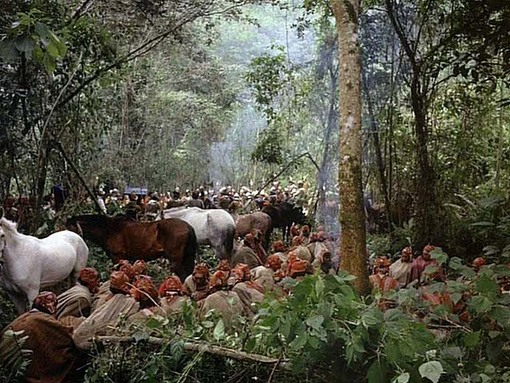
This richly complex composition, which leads the eye around the frame without an obvious focal point, prompted someone to remark on Herzog’s painterly eye — a characterization he rejected. “There are no aesthetics in my films,” he said. I hope he didn’t mean it literally. He may not have been trying for a painterly arrangement (though he did allow that the image somewhat resembled “a still life”), but any time you put a frame around something, you can’t keep aesthetics out. Herzog said he does find it very easy to know where to place the camera, and that when he gathered everyone together here, he found the spot quite rapidly.
I had intended to ask him about what he thought of the Pandoran jungle of “Avatar,” but without mentioning the title he volunteered his opinion as we lingered on this shot: “Today’s films are cowardly,” he said with disgust. “They do not venture into the jungle to photograph it. They create it all in a computer and make cartoons.”

Somebody else remarked again on the portrait-like sensibility of this shot, and again Herzog proudly embraced photography — the actual arrangement of physical objects in space — over painting. He did mention, however, that he posed the two background figures. The man on the right is awkwardly learning to pray over the graves of his comrades who have been given a “Christian burial.”
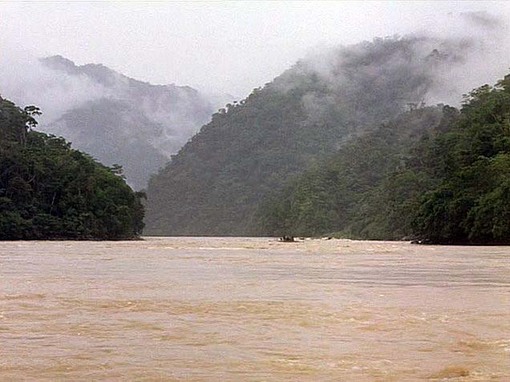
How many takes to get this shot? Once again: one. Herzog pointed out the way the jungle comes right down to the river. There was no way to get the raft back upstream for a second take.
The good part of Francis Coppola’s “Apocalypse Now” (1979), made not long after “Aguirre” was released in the U.S. in 1977, owes much to Herzog’s jungle epic — in atmosphere and sometimes particular images. For all the malevolent mayhem of Kinski, at least Herzog had that face and that Richard III posture to work with (though the voice in the German version is actually looped by someone else). When Coppola got all the way upriver all he found himself with was a fat, bald Brando and a non-ending.

You may recall the downed B-52 from a deleted scene (“Monkey Sampan”) included with the DVD of “Apocalypse Now Redux” (2001). By the time this ship and canoe appear in “Aguirre” (the crew built it up in the tree), the delirious Spaniards are no longer capable of distinguishing between what is taking place before their eyes and what is inside their heads. As a gesture of thanks, Coppola secured American distribution for another Herzog masterpiece, “The Enigma of Kaspar Hauser” aka “Every Man For Himself and God Against All” (1975).

